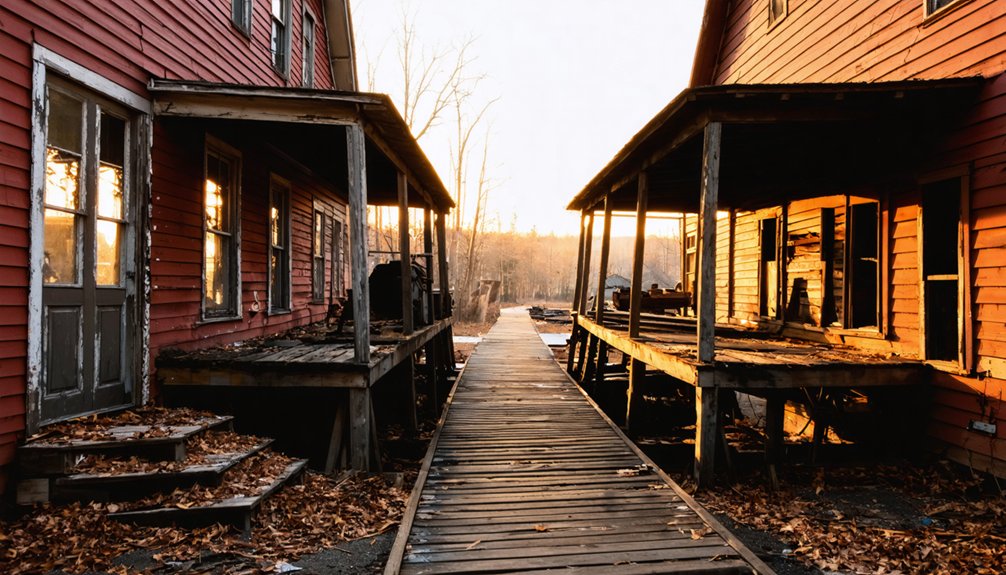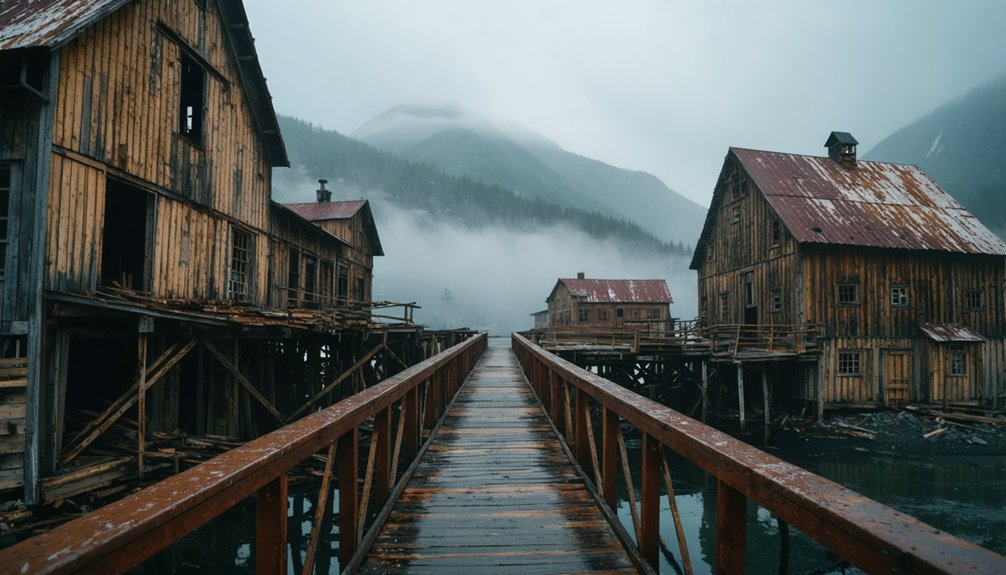When you explore abandoned lumber towns, you’ll encounter weathered remnants of America’s industrial past. These company-owned settlements emerged in the mid-19th century, featuring uniform architecture, company stores, and strict corporate control. You’ll find historical markers, repurposed sawmills, and distinctive land patterns that reveal their logging heritage. From Port Gamble to Diboll, these ghost towns offer windows into workers’ lives and environmental legacies waiting to be discovered beneath the reclaiming foliage.
Key Takeaways
- Abandoned lumber towns feature distinctive architectural patterns, including uniform company housing and repurposed sawmill buildings that now serve as museums.
- Look for telltale signs of former lumber operations through historical maps, GIS tools, and remaining infrastructure like rail lines or mill foundations.
- Visit well-preserved ghost towns that function as living museums showcasing the industrial heritage of America’s logging industry.
- Be aware of environmental hazards at abandoned mill sites, including contaminated soils with heavy metals, PCBs, and pentachlorophenol.
- Photograph abandoned structures during different seasons, utilizing natural light and incorporating storytelling elements like rusting machinery and weathered timber.
The Rise and Fall of American Lumber Company Towns
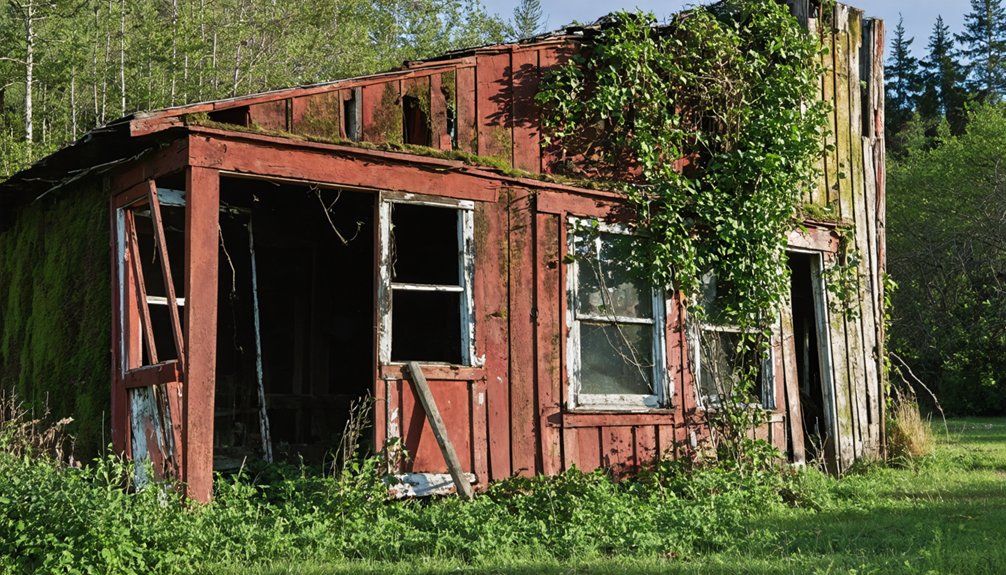
While the vast forests of America seemed limitless to early European settlers, the rise of industrial-scale logging in the mid-19th century gave birth to a unique social experiment: the lumber company town.
You’ll find that the first purpose-built example in Washington Territory—Teekalet (Port Gamble)—emerged in 1853, setting a template for what followed.
These isolated communities expanded dramatically with vital logging innovations of the 1880s: steam-powered equipment and railroads penetrated previously inaccessible forests.
Towns featured rigid social structures where everything—housing, stores, churches—fell under company ownership.
Workers, often recruited from afar, found themselves dependent on employers who sometimes paid in scrip rather than cash. The concept originated in 18th-century Britain during the Industrial Revolution before spreading to North America’s extractive industries.
By the 1830s, Bangor, Maine, had become the world’s largest lumber shipping port, representing the immense scale of the industry before western territories were developed.
How to Identify Former Lumber Towns in the Modern Landscape
Ghosts of America’s timber heritage linger across today’s landscapes, waiting for the discerning eye to discover their stories.
Like silent witnesses to bygone industry, timber’s ghostly presence haunts our landscapes, invisible to all but the curious observer.
When exploring these forgotten chapters of our timber heritage, you’ll find distinctive land use patterns that reveal what once was. Historical maps overlaid with modern imagery expose how urban areas expanded into formerly wooded regions, while architectural remnants tell tales of industrial prosperity.
Look for these telltale signs:
- Repurposed sawmill buildings now serving as museums or offices
- Company-built infrastructure including stores, churches, and schools in towns like Diboll and Lufkin
- Physical vestiges of extraction activity such as railroad grades, scarred hillsides, and distinctive forest boundary patterns
Using specialized software like Map Warper can help rectify historical lumber town maps to modern coordinate systems for more accurate analysis. Communities in the East Texas region continue to celebrate their logging history through local festivals featuring timber competitions that honor traditional skills. GIS tools can help you mark precise coordinates of lost landmarks, creating digital pins where lumber operations once transformed the American wilderness.
Five Most Well-Preserved Ghost Lumber Towns Worth Visiting
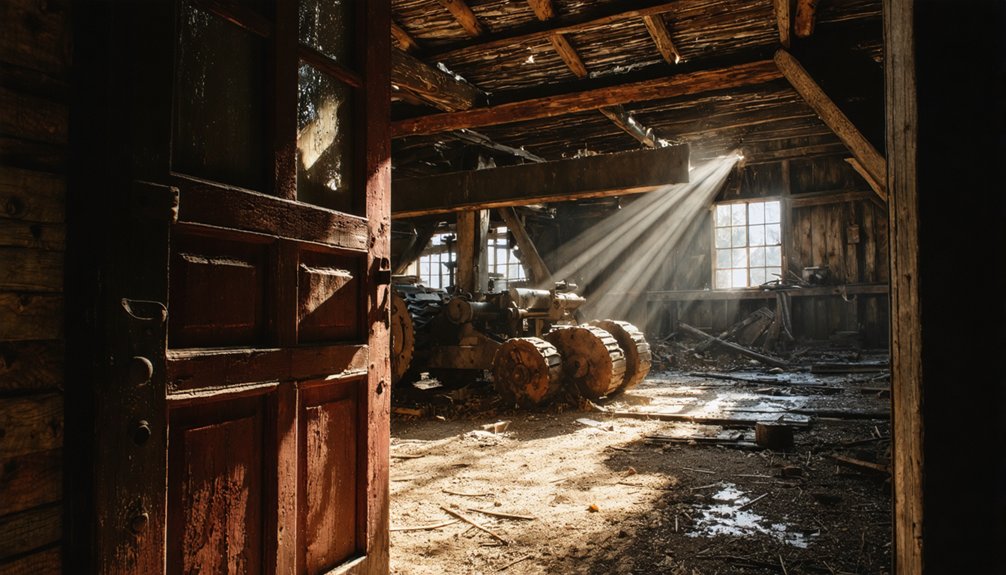
Among America’s forgotten timber landscapes, five remarkably preserved lumber ghost towns stand as living museums to the nation’s woodcutting past.
While mining towns often receive greater attention in ghost town literature, America’s lumber town history offers equally compelling windows into our industrial heritage.
Unfortunately, detailed information about specific well-preserved lumber ghost towns isn’t currently available in our research materials.
The timber industry decline that swept across America in the early-to-mid 20th century left hundreds of abandoned communities, many now reclaimed by the very forests their residents once harvested. Unlike mining towns like Bodie, California which still has over 100 structures standing from its heyday, lumber ghost towns typically have fewer remaining buildings. Similar to Centralia, Pennsylvania, many lumber towns faced environmental hazards that contributed to their eventual abandonment.
To properly identify the most visit-worthy timber ghost towns would require specialized research focusing specifically on lumber communities rather than the mining settlements that dominate most ghost town documentation.
Life in a Company-Owned Lumber Community: Historical Accounts
Life in a company-owned lumber town represented a distinctive American social experiment, where every aspect of existence fell under corporate control.
These isolated communities featured carefully designed infrastructure that served both practical and social needs while maintaining rigid labor relations. Companies like Carlisle Lumber exhibited fierce anti-union sentiment, leading to violent confrontations in the 1930s. In Oregon, thirty-five company towns existed primarily for the timber and lumber industry, though many have disappeared or been repurposed over time.
You would have experienced:
- Economic dependency through company scrip systems, forcing you to purchase necessities exclusively at company-owned stores
- Architectural uniformity following specific regional styles, such as Port Gamble’s New England-inspired gabled roofs
- Community dynamics shaped by essential structures—churches, schools, and dormitories—all serving the company’s production goals
Despite these constraints, these communities formed distinct cultural identities, with residents finding ways to build meaningful lives within the corporate framework. Workers often faced challenging living conditions in segregated communities like Pine Valley, where African American workers were confined to separate sections of the town.
Environmental Legacy: How Nature Reclaims Abandoned Mill Sites
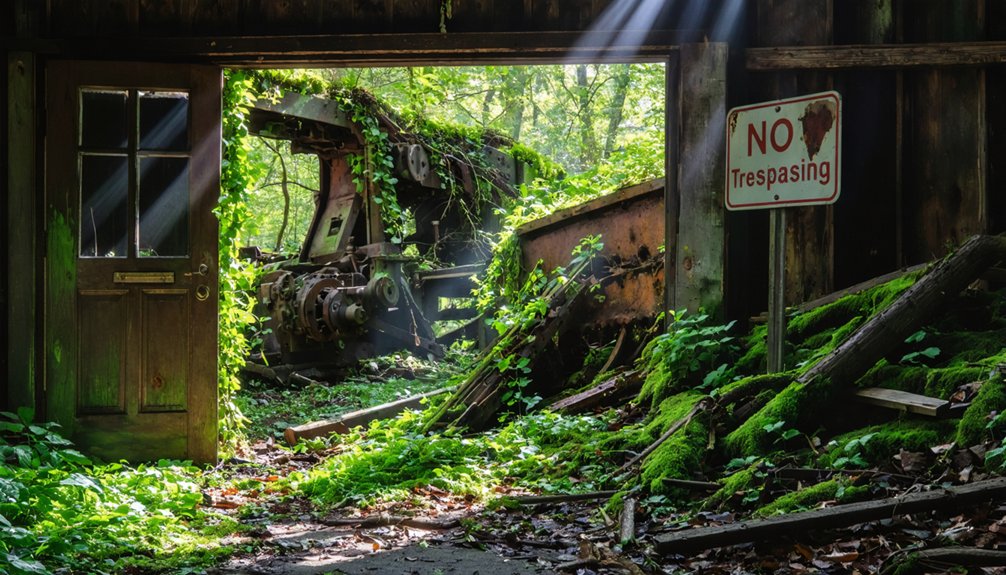
When lumber operations ceased in these once-thriving company towns, they left behind more than just decaying structures and memories—they created complex environmental challenges that continue decades later.
The pollution legacy includes contaminated soils harboring heavy metals, dioxins, and PCBs that threaten groundwater and aquatic ecosystems. At many former lumber mill sites, pentachlorophenol (PCP) widely used as a fungicide continues to pose serious environmental hazards.
If you visit these sites today, you’ll find nature slowly reclaiming them through ecological restoration, both natural and engineered.
Beneath the surface, mill debris—slabwood, metal waste—disrupts aquatic habitats, requiring intensive removal efforts. The Muskegon Lake restoration successfully extracted over 1,318 tons of slag and metal debris to improve the lake bottom habitat. Natural succession gradually reestablishes native vegetation when invasive species are controlled.
Remediation techniques vary from excavation and bioremediation to capping contaminated areas.
While you might see thriving wildlife decades after closure, ongoing monitoring remains crucial to guarantee toxins don’t spread and restoration progress continues.
The Economic Ripple Effect of Lumber Town Abandonment
The closure of a lumber mill reverberates far beyond the immediate loss of sawmill jobs, creating economic shock waves that fundamentally alter the trajectory of entire communities. Michigan’s experience illustrates this harsh reality—273 sawmill positions eliminated triggered 820 additional job losses across related sectors, with economic output plummeting by $211.55 million.
When lumber mills shut down, communities don’t just lose jobs—they lose their economic foundation and future.
These economic impacts devastate community resilience through:
- Shrinking tax bases that cripple local governments’ ability to provide essential services
- Rapid collapse of support businesses as workers migrate elsewhere, accelerating the downward spiral
- Plunging property values that further erode municipal income while leaving authorities responsible for costly maintenance of abandoned structures
You’ll find the true cost extends beyond statistics—lumber mills function as microeconomic hubs whose absence fundamentally reshapes rural regions with few alternative employment opportunities.
Photography Tips for Capturing Abandoned Lumber Architecture
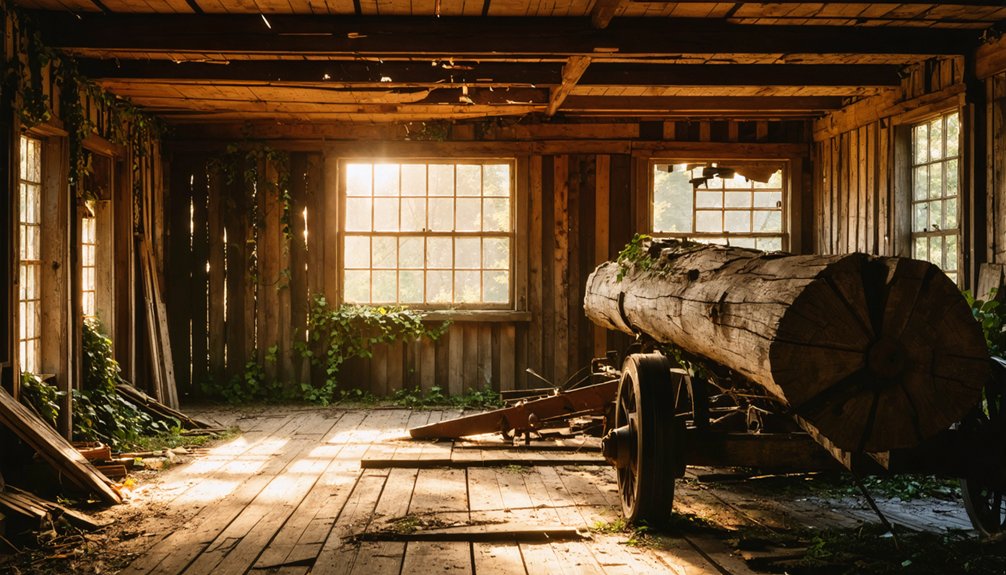
When photographing abandoned lumber architecture, you’ll achieve more authentic results by working with available light that streams through broken windows and gaps, emphasizing the natural decay rather than artificially illuminating spaces.
Your composition should incorporate storytelling elements like rusting machinery, weathered timber beams, and scattered artifacts that reveal the human narrative of these once-thriving industrial spaces.
Different seasons offer unique photographic advantages—winter’s stark light and bare trees expose structural details, while spring and summer introduce the compelling visual tension of nature reclaiming human-made structures through vegetation growth.
Lighting For Authenticity
How effectively you capture the haunting beauty of abandoned lumber towns depends largely on mastering lighting techniques that honor their authentic character.
Balance natural and artificial illumination techniques by using streaming sunlight through broken structures while supplementing with strategic flashlight or LED placement. This approach preserves the atmospheric integrity while revealing essential architectural details.
For compelling shadow play effects, consider:
- Positioning your camera to capture light rays cutting through dust particles during golden hour
- Using long exposures with a tripod while “painting” specific structural elements with a flashlight
- Embracing the dramatic contrast between illuminated features and areas left deliberately in shadow
Don’t overlight these spaces—their authenticity lives in the interplay between revelation and mystery, much like the towns’ histories themselves.
Compositional Storytelling Elements
With lighting considerations established, powerful compositional elements become your next storytelling tools when photographing abandoned lumber towns.
Employ leading lines found in corridors, staircases, and fences to guide viewers deeper into your visual narratives. Experiment with unconventional perspectives—shooting from ground level upward can dramatically emphasize architectural scale and interior vastness.
Frame your subjects through doorways and windows to create focal hierarchy, and seek out symmetry in repetitive elements to evoke haunting balance.
Your compositional techniques should incorporate texture contrasts that reveal the passage of time: peeling paint against solid beams, weathered wood beside encroaching nature. These textural juxtapositions tell stories of human departure and environmental reclamation.
Consider incorporating abandoned objects—tools, furniture, machinery—as emotional anchors that hint at the lives once lived within these forgotten spaces.
Seasonal Shooting Advantages
The changing seasons offer distinct advantages for photographers documenting abandoned lumber towns, each presenting unique lighting conditions and atmospheric elements that transform these forgotten places.
Winter aesthetics provide flat, even illumination that reveals the subtle textures of weathered timbers, while spring photography captures the poignant contrast between new growth and decaying structures.
- Shoot during golden hour in any season to bathe dilapidated sawmills in warm, dimensional light that accentuates architectural details.
- Exploit fog and mist in fall months to create ethereal, moody compositions that speak to the town’s abandoned narrative.
- Utilize winter’s snow cover to simplify complex scenes, highlighting the essential structural elements against pristine white backgrounds.
Always adapt your equipment to seasonal conditions—tripods for winter’s low light, polarizers for spring’s reflective surfaces.
Preservation Efforts: Saving America’s Timber Heritage

You’ll find numerous abandoned lumber towns across America now protected through National Register of Historic Places designations, which provide essential legal frameworks for preservation and restoration funding.
Community-led restoration projects, like those in Falk and other timber heritage sites, depend on partnerships between local volunteers, preservation organizations, and government agencies to secure grants often exceeding $300,000.
These collaborative efforts not only stabilize deteriorating structures but also transform these once-forgotten places into educational resources that connect visitors with America’s rich logging history.
Historic Site Designation
Preservation efforts for America’s abandoned lumber towns have gained significant momentum through formal historic site designations, particularly through the National Register of Historic Places.
These designations document the cultural significance of once-thriving communities like Maxville Historic District in Oregon and lumber sites along the Pacific Coast, preserving America’s timber heritage for future generations.
When you explore these protected historic districts, you’ll discover:
- Archaeological remains spanning 107-acre areas containing thousands of industrial and domestic artifacts
- Original town layouts including worker housing, privies, schoolhouses and abandoned logging railroad infrastructure
- Preserved sawmill sites that maintain their basic configuration and integrity, offering insight into industrial operations dating to the 1800s
The designation process, established in 1966, now protects over 12,000 American towns documenting our nation’s economic and industrial development.
Community-Led Restoration Projects
While historic site designations provide official recognition of lumber towns’ significance, grassroots initiatives have emerged as powerful catalysts for physical restoration.
Community engagement thrives when local expertise meets preservation needs—former miners in Silverton now apply their skills to stabilization projects, while volunteers contribute equipment and labor across restoration sites.
Restoration funding follows diverse channels, with projects like Animas Forks securing $330,000 in grants alongside the $6.5 million invested in Feltville’s infrastructure.
These investments yield tangible results: climate-controlled archives protecting historical documents, stabilized structures like the precariously perched Old Hundred Mine boarding house, and modern amenities that balance preservation with safety.
Your access to this timber heritage continues expanding through Thursday archive openings, guided tours, and interpretive panels that contextualize these once-abandoned towns’ significance.
Frequently Asked Questions
Is It Legal to Explore Abandoned Lumber Towns on Private Property?
No, you’re not free to trample property rights—these decaying paradises aren’t yours to explore. You’ll need explicit legal permissions, regardless of how abandoned they appear. Trespassing remains trespassing.
What Safety Hazards Should Explorers Watch for in Abandoned Lumber Sites?
You’ll face structural instability risks including collapsed floors, roofs, and bridges, plus toxic materials from chemical residues, asbestos, and mine contaminants. Beware of unmarked mine shafts and rusty metal hazards.
Were Lumber Towns Racially Segregated During Their Operational Years?
Yes, you’ll find most lumber towns enforced strict racial segregation, with housing and facilities divided by race. These racial dynamics fundamentally shaped community structure, reflecting America’s broader Jim Crow segregation patterns.
Did Any Lumber Towns Successfully Transition to Sustainable Industries?
You’ll find Michigan towns like Deward successfully pivoted to sustainable practices through farming and fruit orchards. Others embraced tourism, while modern industry innovation in bioenergy and mass timber has created new pathways for former logging communities.
What Artifacts Are Commonly Found in Abandoned Lumber Town Sites?
You’ll discover saw blades, logging tools, mill equipment, cookware, bottles, and personal effects at abandoned lumber sites. These lumber artifacts hold historical significance, revealing workers’ lives and industrial practices.
References
- https://www.wideopencountry.com/the-10-eeriest-ghost-towns-in-america/
- https://247wallst.com/special-report/2016/11/12/20-american-ghost-towns/
- https://www.geotab.com/ghost-towns/
- https://socialwelfare.library.vcu.edu/organizations/labor/company-towns-1890s-to-1935/
- https://www.lovemoney.com/gallerylist/86648/americas-empty-ghost-towns-and-why-theyre-abandoned-today
- https://infrastructureusa.org/spooky-infrastructure-ghost-towns-across-the-united-states/
- https://en.wikipedia.org/wiki/Lists_of_ghost_towns_in_the_United_States
- https://www.loveexploring.com/gallerylist/188219/the-us-state-with-the-most-ghost-towns-revealed
- https://www.historylink.org/File/23208
- https://en.wikipedia.org/wiki/History_of_the_lumber_industry_in_the_United_States
